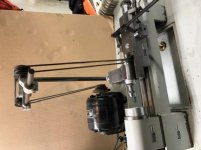scooternut
Plastic
- Joined
- Nov 30, 2017
- Location
- Washington, PA
Good Day All.
I am working on a vintage Levin Lathe, the literature suggests 60's era, though these are still produced. The machine is a "precision instrument lathe" The machine has a DC motor underdrive headstock, with its own variable speed controller, reversing switch, and foot pedal control.
The machine has as an accessory, a table mounted DC motor with its own variable speed controller,reversing switch, and the same foot pedal control (wired to both controllers)
ISSUES:
1) The foot pedal switch does not operate the accessory drill motor, controller and motor works when jumpered. The foot pedal does work the underdrive, and appears connected (did not test yet)
2)PRIMARY ISSUE, the drill accessory motor will only run in reverse (when the foot switch is jumpered as above).
Thankfully, I have schematics for the machine, I will attach pics, but I'm still having trouble with diagnostics. I am trying to use a multimeter to learn how the controller works, to track the forward run problem. However, I am unable to get continuity from power in, to any wires going to the motor when it is in a condition that I know it runs, aka reverse, with foot switch jumpered. In my mind, if I can't do this, then I can't work backwards. Oh, the Fw/ rev switch tests out OK with continuity test.I haven't tried to test anything under power.
Is this due to the mechanical electro switches in the controller? I can hear and see them operate when I'm working the power and/ or reversing switch.
Any advice?
Additionally, I have schematics for the other controller if you own a vintage Levin yourself, just hit me up for a copy.




I am working on a vintage Levin Lathe, the literature suggests 60's era, though these are still produced. The machine is a "precision instrument lathe" The machine has a DC motor underdrive headstock, with its own variable speed controller, reversing switch, and foot pedal control.
The machine has as an accessory, a table mounted DC motor with its own variable speed controller,reversing switch, and the same foot pedal control (wired to both controllers)
ISSUES:
1) The foot pedal switch does not operate the accessory drill motor, controller and motor works when jumpered. The foot pedal does work the underdrive, and appears connected (did not test yet)
2)PRIMARY ISSUE, the drill accessory motor will only run in reverse (when the foot switch is jumpered as above).
Thankfully, I have schematics for the machine, I will attach pics, but I'm still having trouble with diagnostics. I am trying to use a multimeter to learn how the controller works, to track the forward run problem. However, I am unable to get continuity from power in, to any wires going to the motor when it is in a condition that I know it runs, aka reverse, with foot switch jumpered. In my mind, if I can't do this, then I can't work backwards. Oh, the Fw/ rev switch tests out OK with continuity test.I haven't tried to test anything under power.
Is this due to the mechanical electro switches in the controller? I can hear and see them operate when I'm working the power and/ or reversing switch.
Any advice?
Additionally, I have schematics for the other controller if you own a vintage Levin yourself, just hit me up for a copy.





